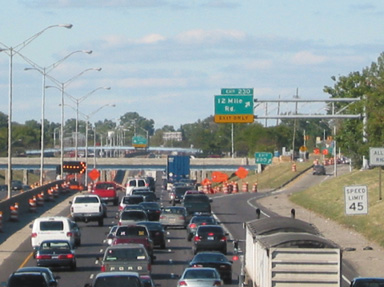| Skip
to content |
|
|
|
Corridor Traffic ManagementThis publication is an archived publication and may contain dated technical, contact, and link information.Corridor Traffic Management Challenges When congested traffic conditions occur on one roadway, travelers typically respond by shifting to another route, selecting a different roadway (freeway versus surface street), adjusting their trip to another time of day, or remaining on their current route encountering significant delays. These disruptions range in scale, frequency, predictability, and duration. Depending on the cause, they have the potential to affect a number of transportation facilities or modes. Why We're ConcernedIn the 21st century we have the potential to significantly improve mobility and reduce the effects of congestion when travel is disrupted on freeways or surface streets within urban corridors. Agencies have placed a lower priority and a lower focus on continuously improving the real-time coordination, management, and control of traffic in response to changing traffic and roadway conditions across jurisdictions' boundaries or between freeways and surface streets. Here are a few examples of why improvements are important and needed:
What We've LearnedProactively managing and coordinating the control of traffic is a viable and effective strategy to improve the safety, efficiency and reliability of traffic on and between freeways and surface streets within urban corridors. Agencies have successfully demonstrated that these practices can reduce travel times, improve travel reliability, increase traffic throughput, decrease crashes, and reduce the number of stops and delay at traffic signals. Achieving these results requires an aggressive traffic operations program, strong partnerships between agencies, commitment of necessary resources and support, deployment of technology and traffic control systems, development of operational strategies and control plans, and proactive management and control of traffic within freeway corridors in metropolitan areas. Using managed lane strategies, alternate routing of traffic, operational strategies, coordinated control plans, proactive management and control of traffic, and coordinated response to changing conditions offers the potential to achieve significantly greater use of the existing roadway capacity. Examples of near term opportunities agencies may pursue include:
Corridor traffic management can positively mitigate the impacts of congestion and improve traffic operations within freeway corridors in urban and rural areas. Motorists traveling within these corridors will experience safer, more efficient and reliable travel due to fewer interruptions resulting from various congestion-causing events.  Future DirectionThe Federal Highway Administration (FHWA) has defined priority areas for attention and near term action, including congestion mitigation. FHWA will pursue initiatives to provide incentives for the private sector to develop the needed tools, increase agency awareness of the benefits, encourage regional planning and coordination, deploy technologies, and use recommended practices to proactively manage and control traffic within freeway corridors in response to changing conditions. These initiatives will involve: Collaboration and Consensus BuildingFormulate and gain acceptance of the research and technology transfer needs to advance the practices of agencies Raise Awareness and Motivate ActionFacilitate peer-to-peer exchanges, regional workshops, executive briefings, and tabletop exercises to raise agencies' awareness of the benefits to improving current practices Technical Guidance and Capacity BuildingDevelop and deliver guidance material and training and self-assessment tools for agencies to develop action plans to improve current practices Applied ResearchDevelop tools, conduct field operational tests, quantify potential benefits, and prepare materials to assist with implementing innovative applications The near term priorities for projects to be pursued will focus on:
CoordinationThe Corridor Traffic Management program and the Integrated Corridor Management ITS Tier one initiative complement and support each other. The Corridor Traffic Management focus is to coordinate the operations and develop joint operational strategies for corridor freeways and arterials. The Integrated Corridor Management initiative focus is to facilitate the wider integration of corridor operations across corridor facilities and modes. The two efforts are coordinated to support the integration of corridor traffic operational strategies with other corridor facilities. The complementary effort will support specific investigation and development of traffic related, freeway and arterial, operational strategies while supporting the integration of these strategies with other corridor based operations. For more information on Integrated Corridor Management activities please visit http://www.its.dot.gov/icms/index.htm. |
|
United States Department of Transportation - Federal Highway Administration |
||